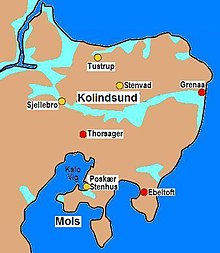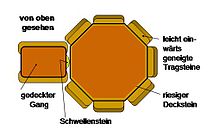Runddysser in Klemstrup Skov
The Runddysser in Klemstrup Skov (forest) are located in Djursland on both sides of Klemstrupvej, a road between Ryomgård and Pindstrup in Jutland in Denmark . The dolmens are partially restored and provide examples of the region's low round dolmens. The dolmen on the north bank of Kolindsund , which separated Djursland between Grenaa and Allingåbro before silting up and was an island in the Neolithic, was built between 3500 and 2800 BC. BC as megalithic systems of the funnel beaker culture (TBK). The area is rich in dolmens and in many ways forms the northern counterpart to the concentration around Nødager south of Kolindsund. Neolithic monuments are an expression of the culture and ideology of Neolithic societies. Their origin and function are considered to be the hallmarks of social development.
The southern dolmen
The Dysse south of the road has an almost intact ring of 24 large curbs, which originally bordered the almost completely eroded mound that covered the facility southeast of the middle of the hill. In the southeast there are two pairs of stones that belong to the corridor that opened up the pentagonal polygonal pole made of almost 1.5 m high, inwardly inclined stones. The only capstone typical of dolmens of this type is missing. The dolmen has not been archaeologically examined and no findings are known.
The northern dolmen
The dysse north of the street is an almost identical round dysse about 11 m in diameter. In the ring of 28 large curbs, most of the stones are still upright. Of the chamber, which is also facing southeast, only three bearing stones have been preserved. The once pentagonal chamber of this polygonal hollow is surrounded by blasted stones, which originally belonged to it, while gang stones and mounds of earth are not visible.
See also
literature
- Jakob Vedsted: Fortidsminder og Kulturlandskab. En kildekritisk analysis af tragtbaegerkulturens found material from Norddjursland. Forlaget Skippershoved, Ebeltoft 1986, ISBN 87-981329-5-4 .
Individual evidence
- ↑ (Danish. Runddysse) is the name commonly used in Denmark for dolmens that are located in a round hill. In contrast, dolmens lying in a rectangular or trapezoidal barn bed are called long dolmens
- ^ Johannes Müller : Neolithic Monuments and Neolithic Societies. In: Hans-Jürgen Beier , Erich Claßen, Thomas Doppler, Britta Ramminger (eds.): Varia neolithica VI. Neolithic Monuments and Neolithic Societies. Contributions from the meeting of the Neolithic Working Group during the annual meeting of the North-West German Association for Ancient Research in Schleswig, 9. – 10. October 2007 (= contributions to the prehistory and early history of Central Europe. Vol. 56). Beier & Beran, Langenweißbach 2009, ISBN 978-3-941171-28-2 , pp. 7-16, here p. 15.
Web links
Coordinates: 56 ° 23 '14.3 " N , 10 ° 27' 0.3" E









